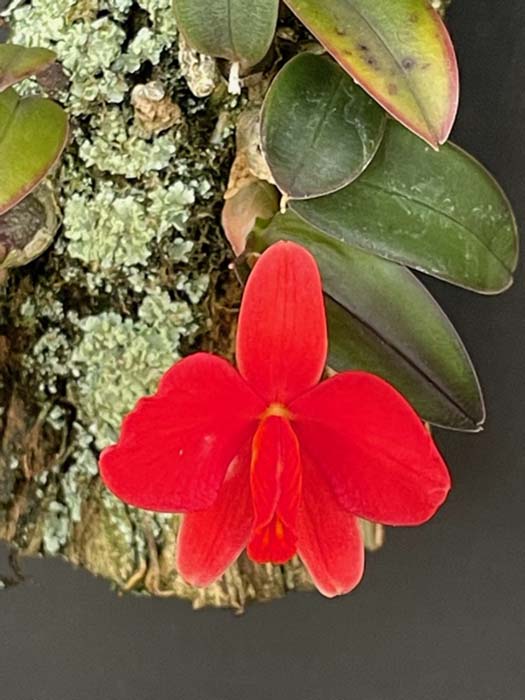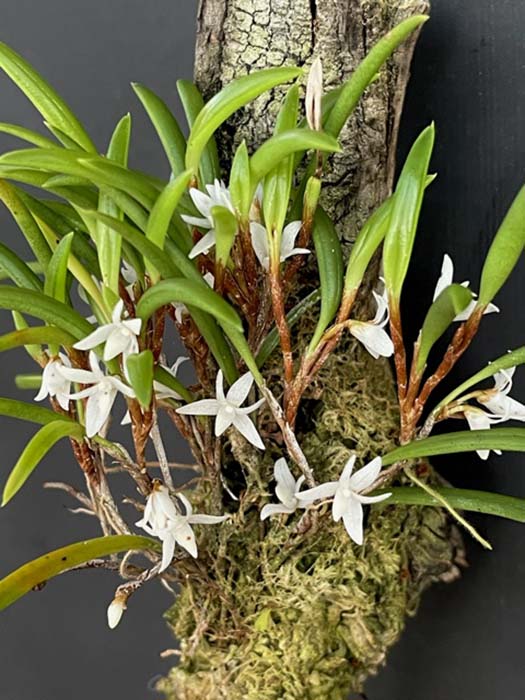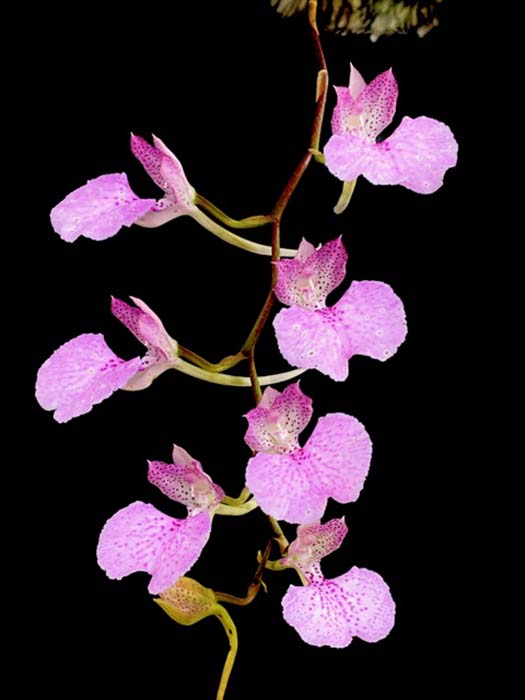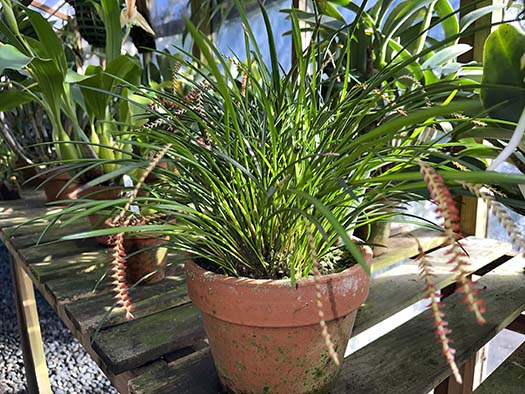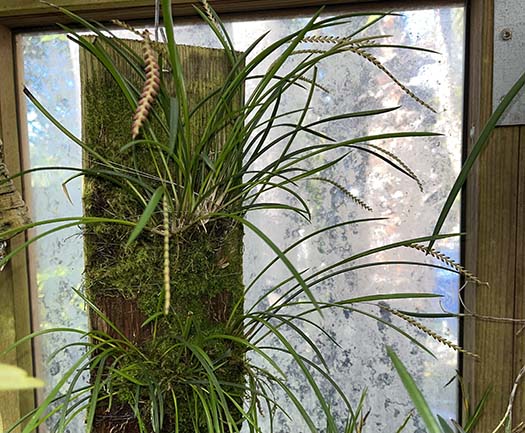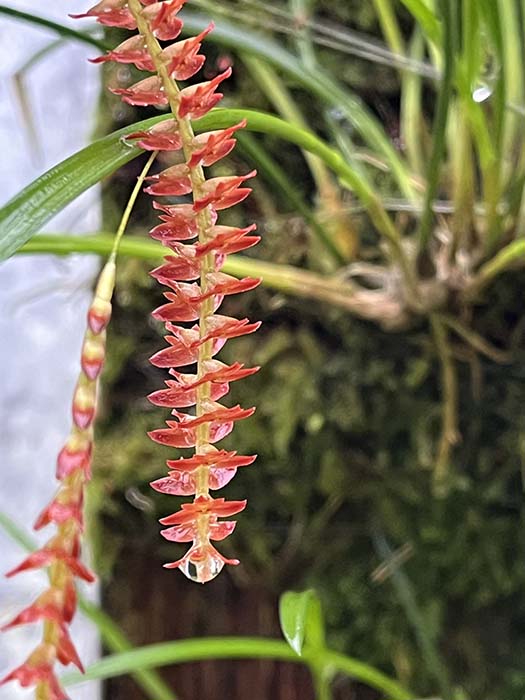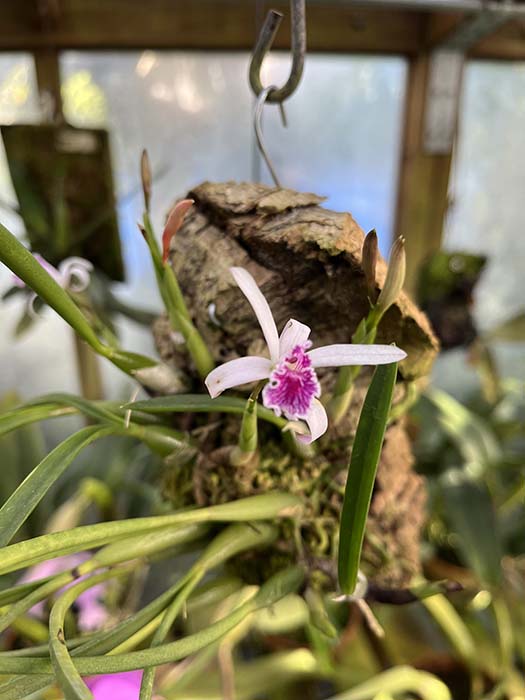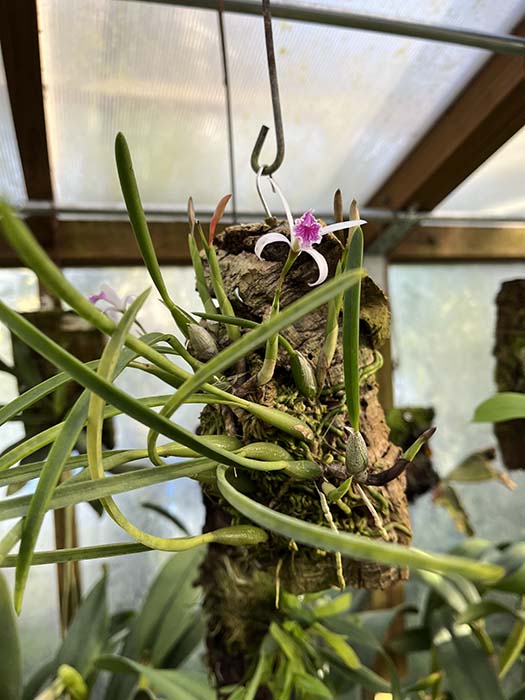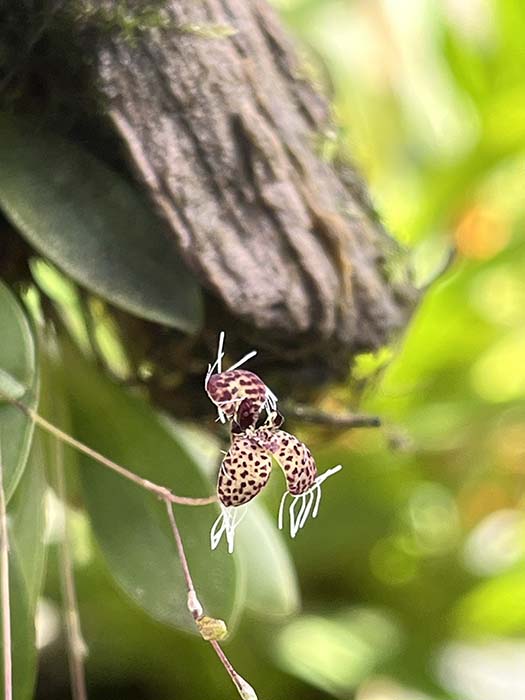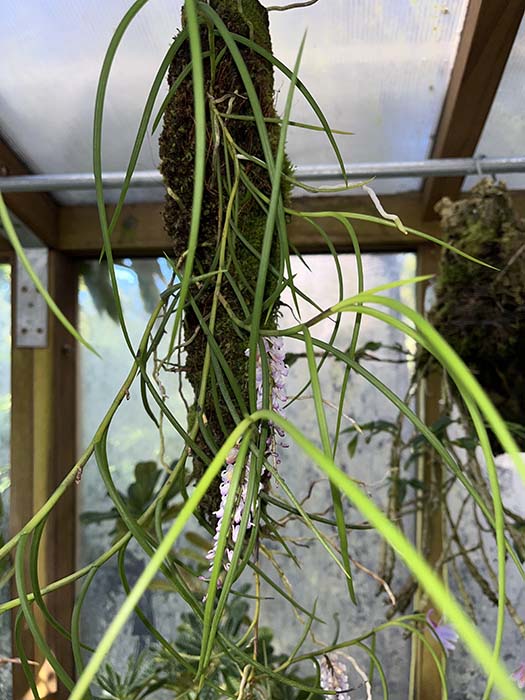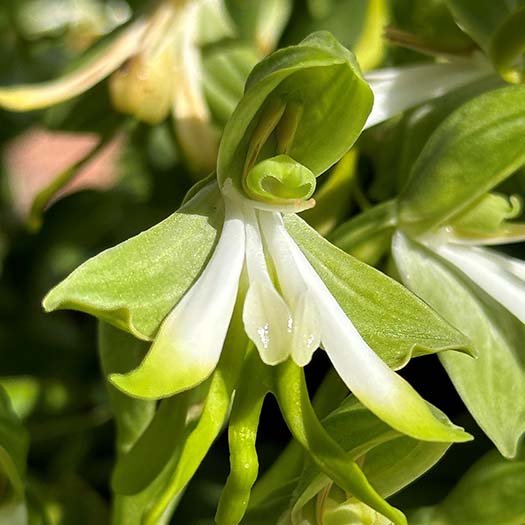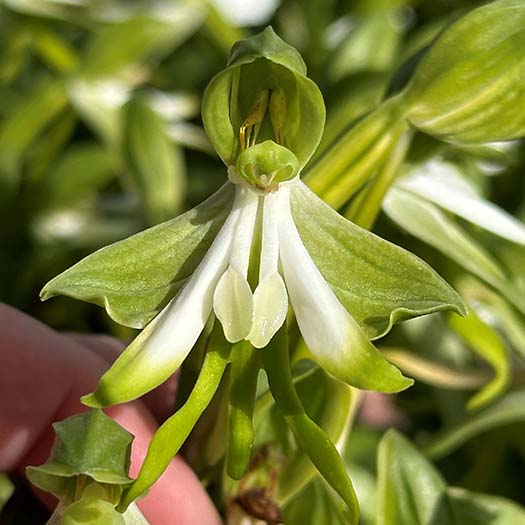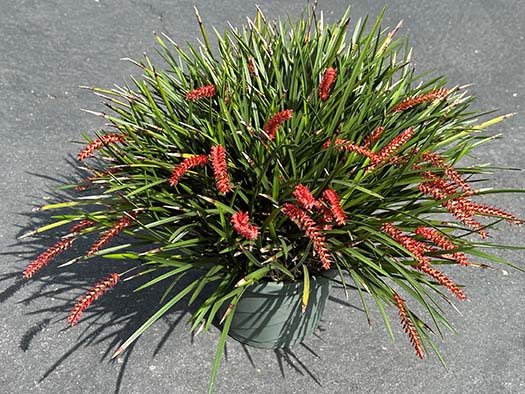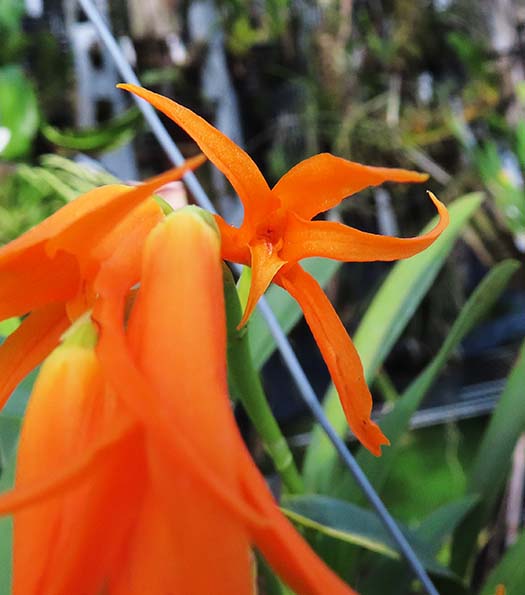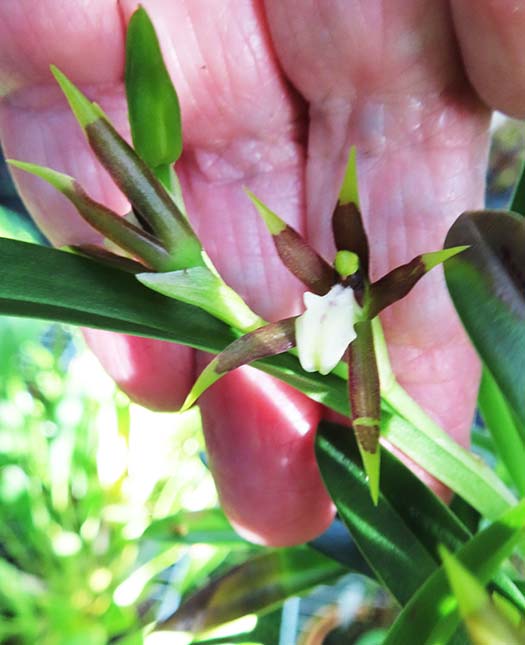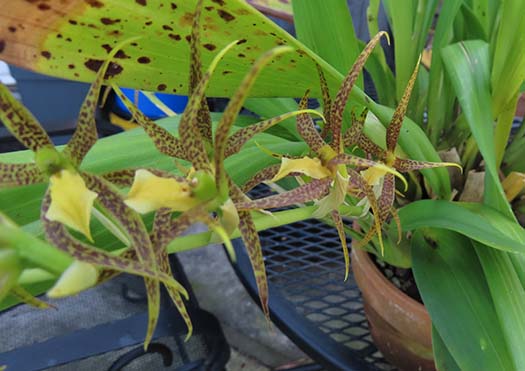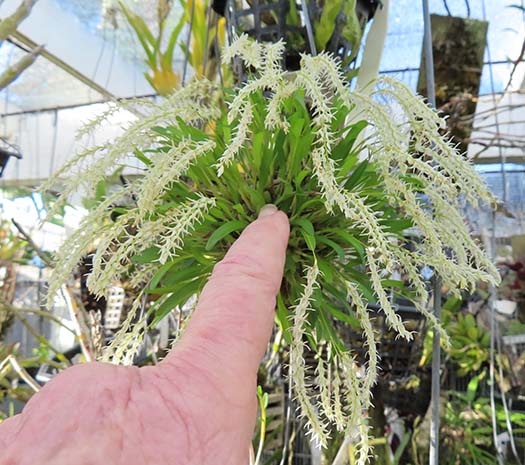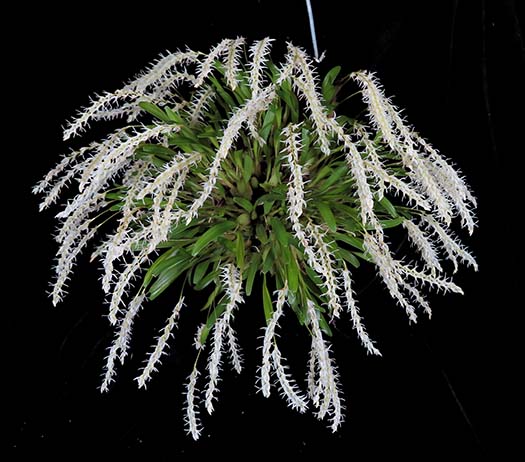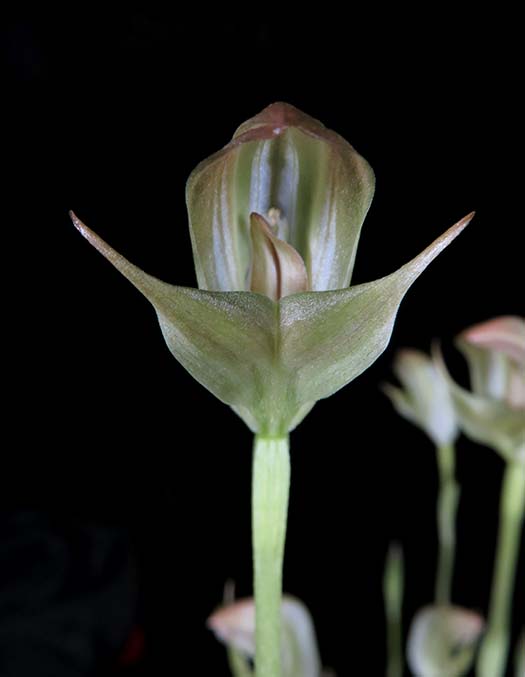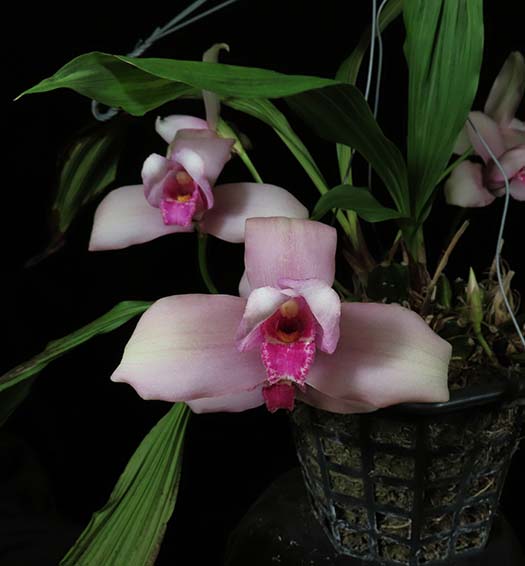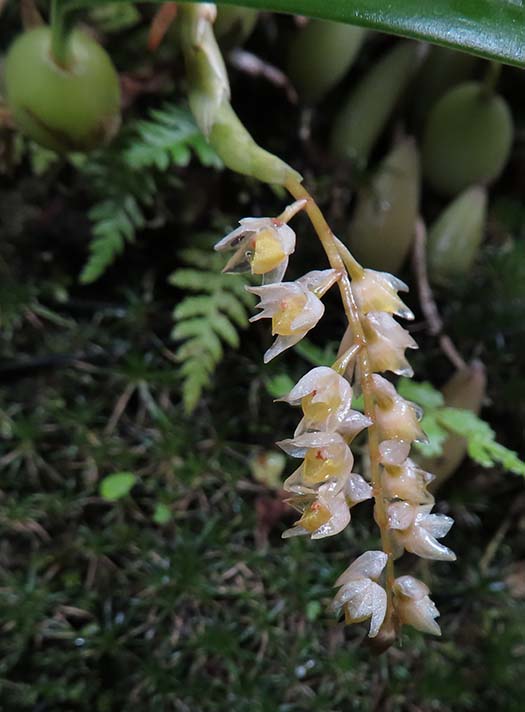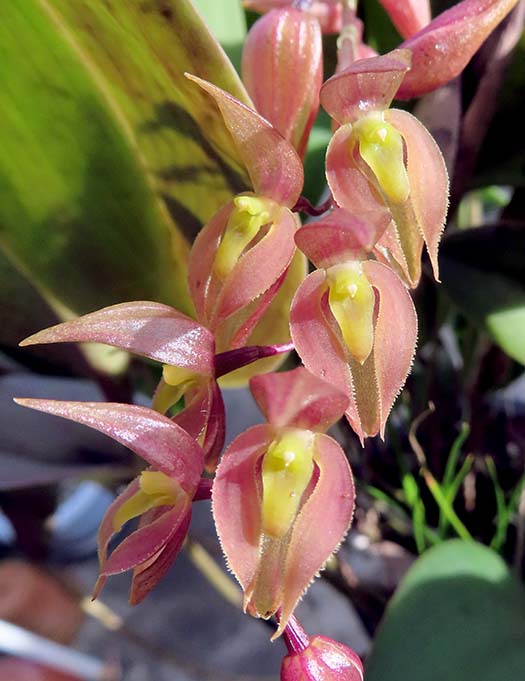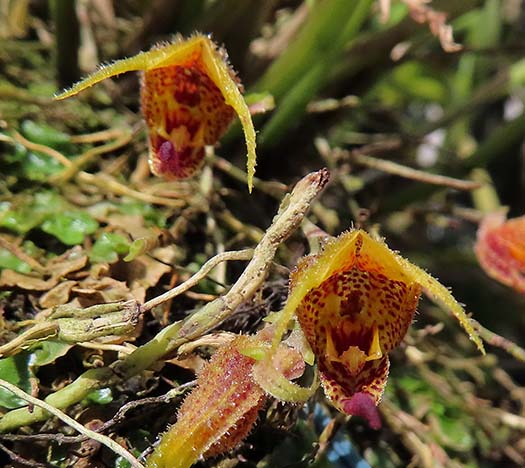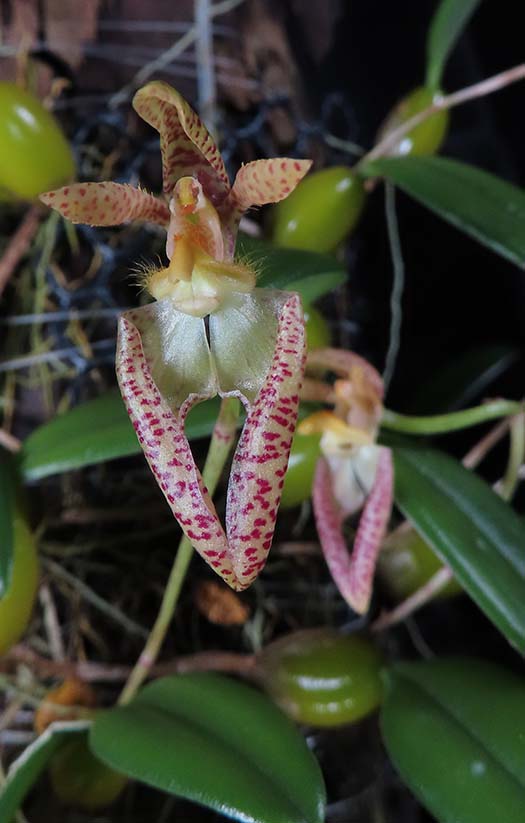March 2024
From Kurt Shanebeck:
|
|
Outdoors coastal, north of Los Angeles: |
|
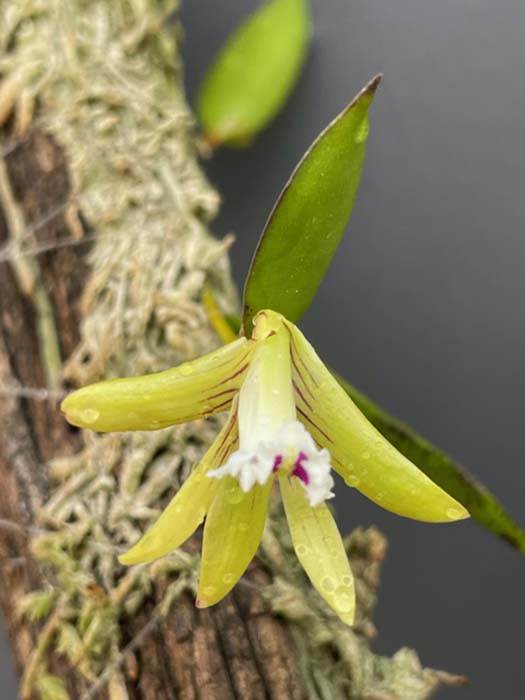
Dendrobium pugioniformeAustralian epiphyte with long wiry stems. Growing mounted with bright light. |
|
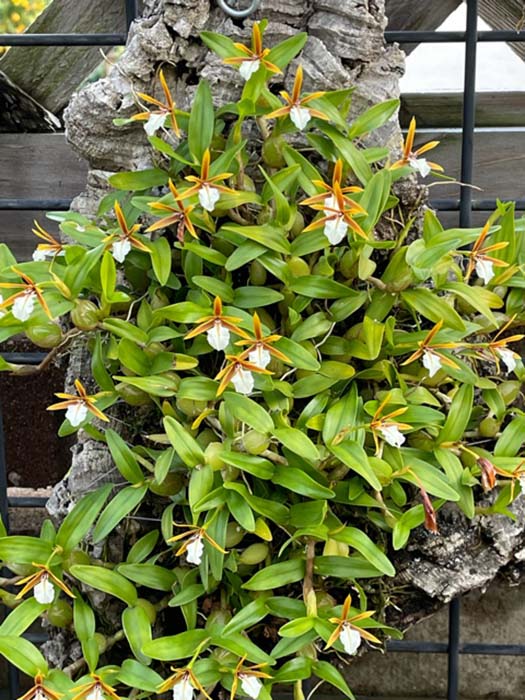
Dinema polybulbonNative to Mexico and Central America. Creeping growth habit. Growing mounted with bright light. |
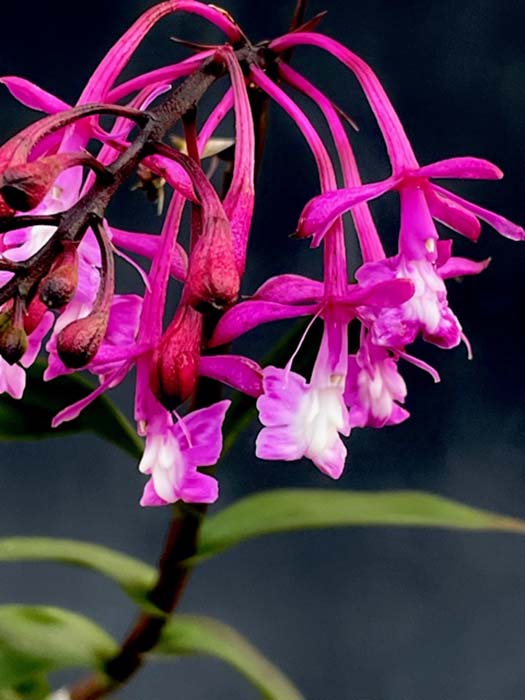
Epidendrum porphyreumFound in Ecuador and Columbia as an epiphyte or terrestrial at elevations of 1800-3900m. Growing potted with bright light. |
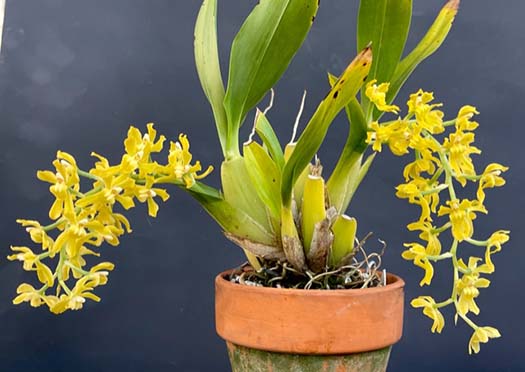
Gomesa recurvaEpiphyte or terrestrial from Brazil. Growing potted with moderately bright light. |
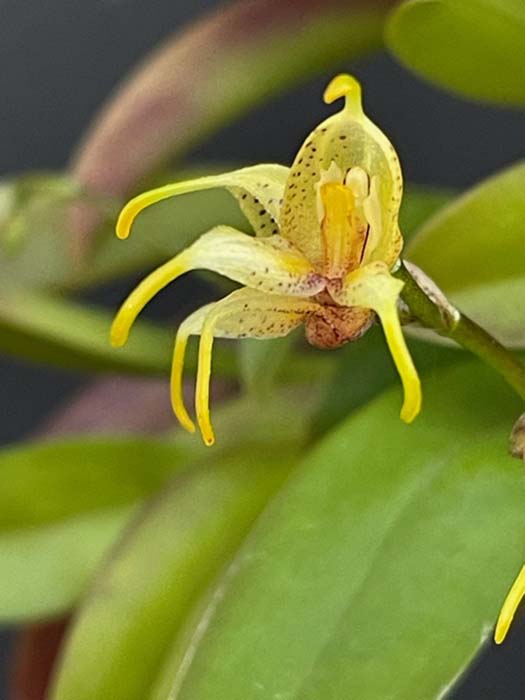
Masdevallia polystictaFrom Ecuador and Peru at elevations of 1600-3000m. Growing potted and shady. |
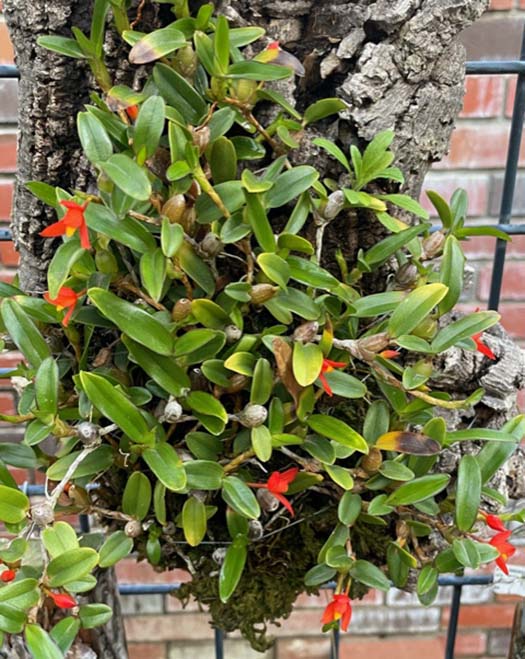
Maxillaria sophronitisNative to Venezuela and Columbia at elevations of 750-1700m. Growing mounted with bright light. |
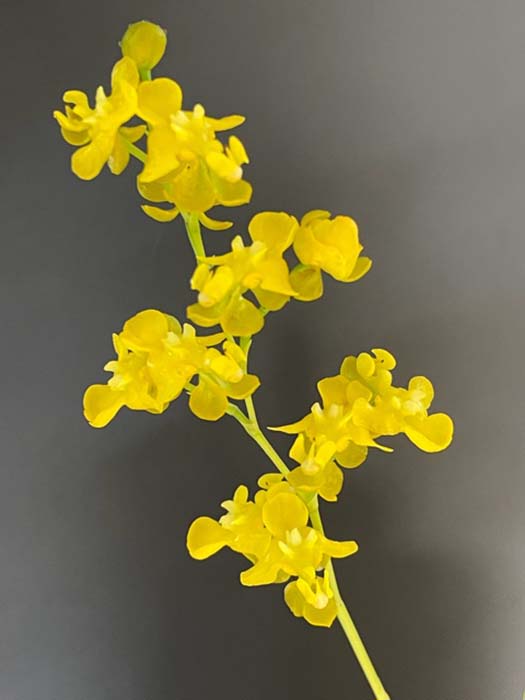
Oncidium cheirophorumA small plant native to Mexico and Central America at elevation of 1000-2500m |
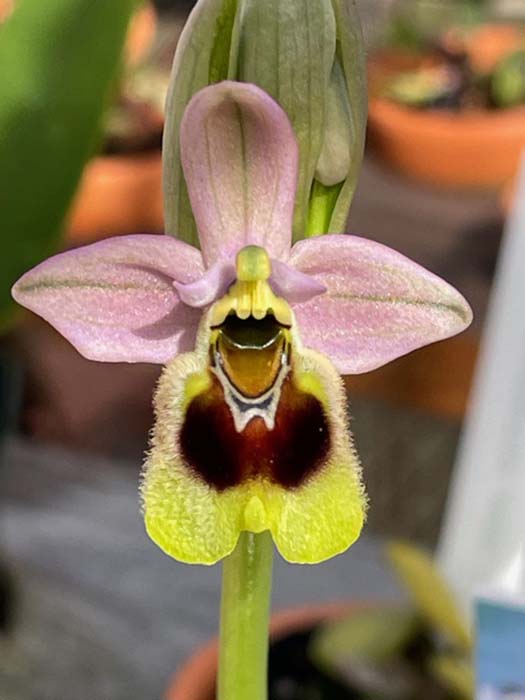
Ophrys tenthrediniferaMediterranean terrestrial species. Growing potted in pumice with coconut coir and given bright light. |

Schoenorchis brevirachisA small Vietnamese epiphyte. Growing mounted with bright light. |
From Arnold Markman:
|
|
Intermediate Greenhouse, coastal San Diego area
|
|
Coelygyne cristataWatered every 2-3 days |
|
Cattleya (Laelia) lundiiThis species is unusual compared to related species in that it has two leaves from most pseudobulbs.. Likely the only two-leafed Laelia in found in Brazil. (Ed: However, now classified as Cattleya, there are many bifoliate Cattleya species, of course.) |
|
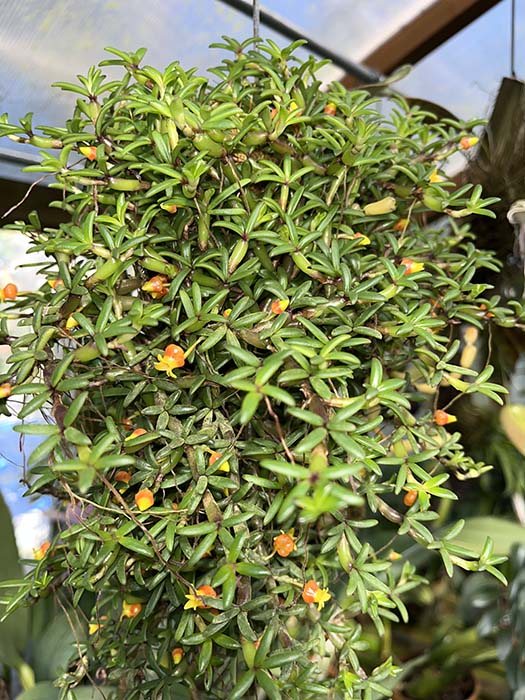 |
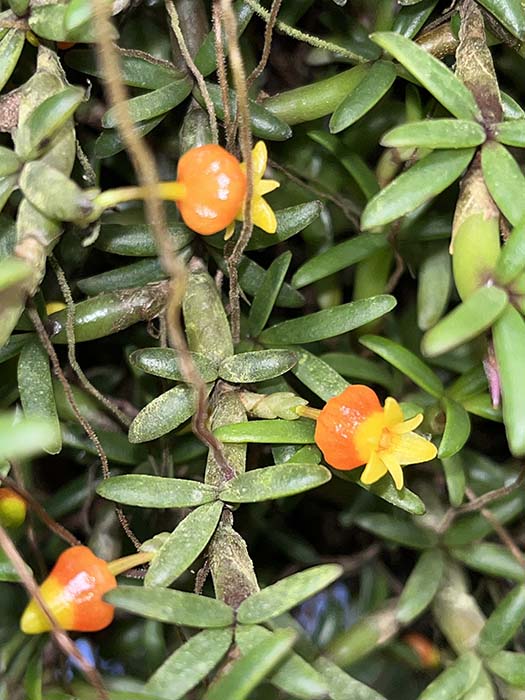 |
Mediocalcar decoratum |
|
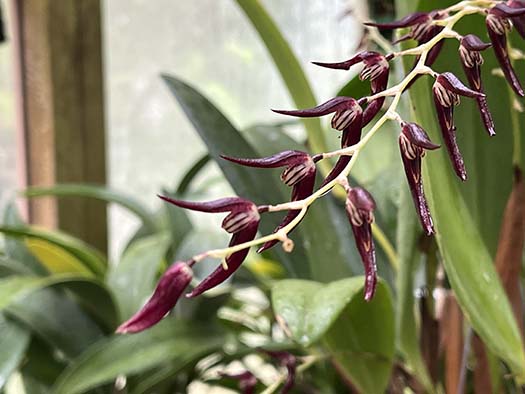 Pleurothallis tuerkheimii |
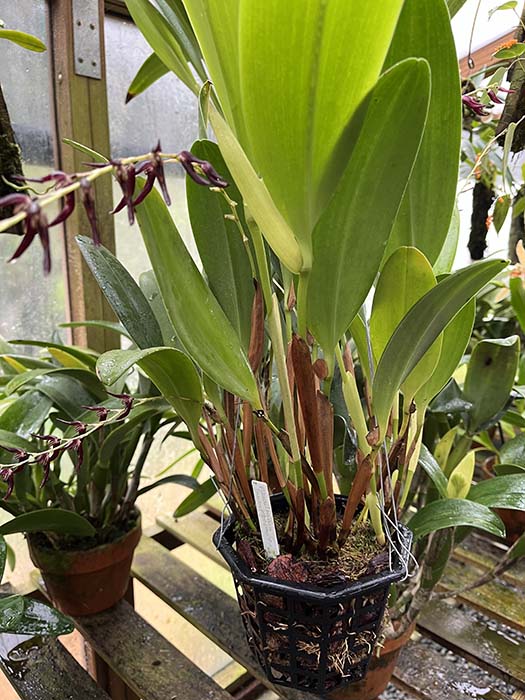 |
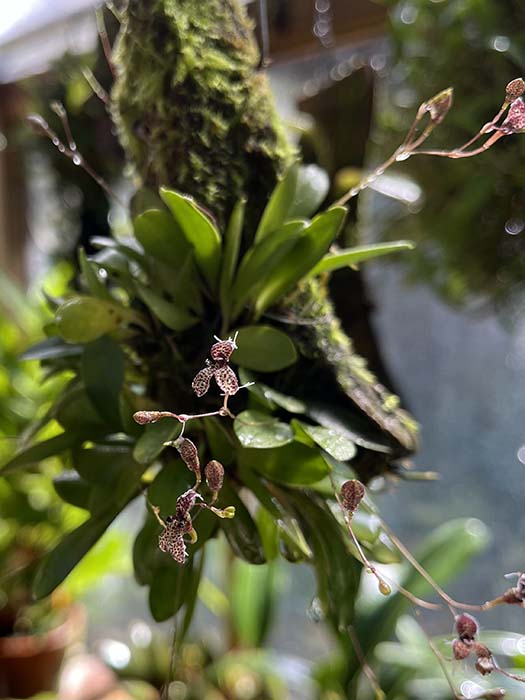 |
|
Pleurothallis ornata |
|
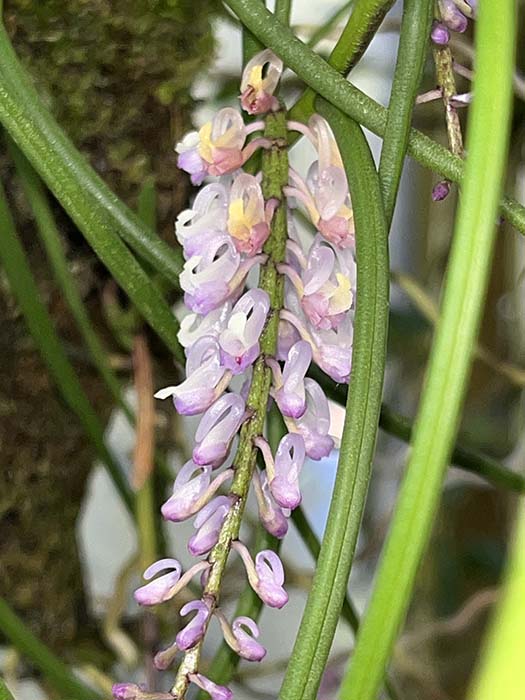 |
|
Schoenorchis juncifolia |
|
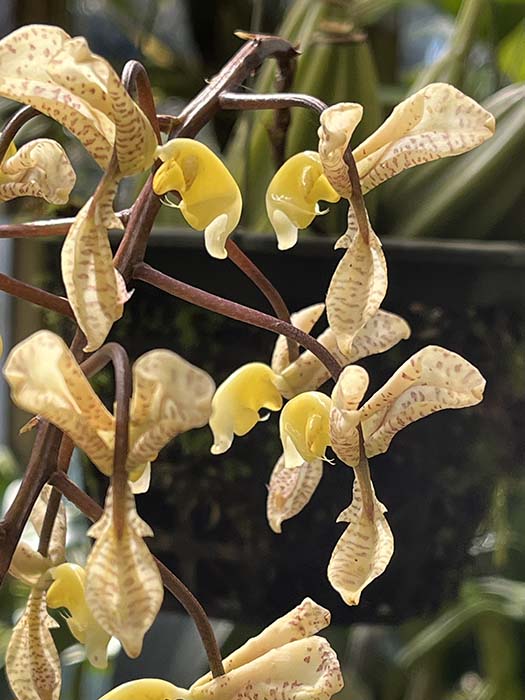 Gongora scaphephorus |
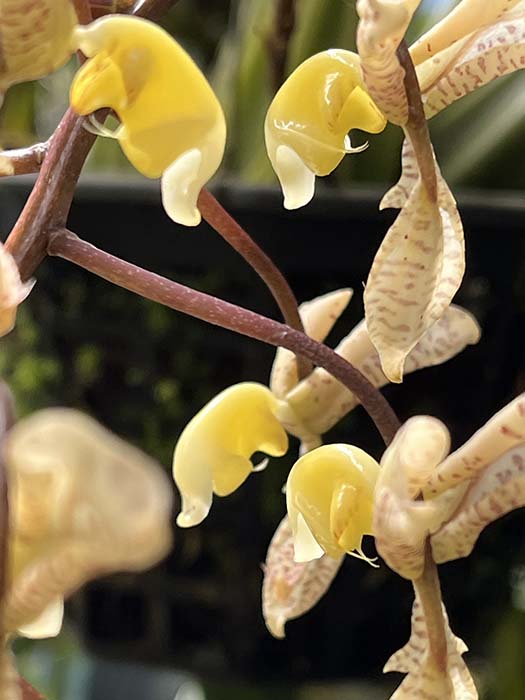 |
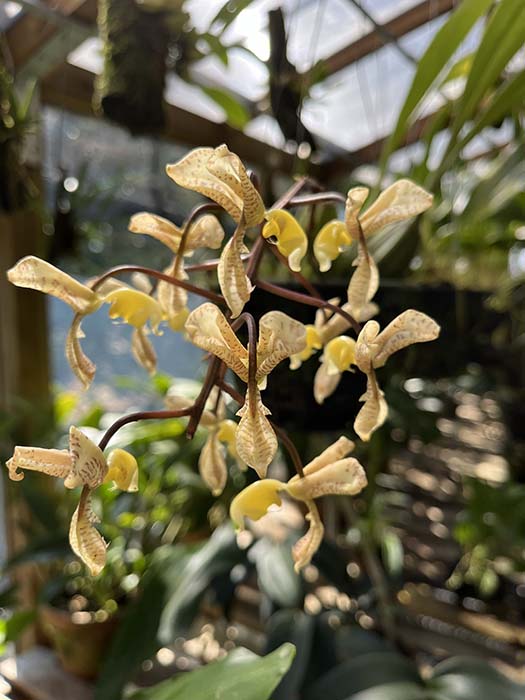 |
|
From Scott McGregor:All orchids grown outdoors, coastal southern California |
|
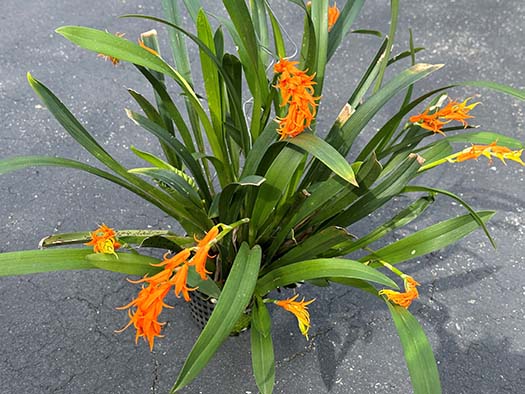 Ada (Brassia) aurantiacaSaturated orange flowers to brighten the winter days!
|
|
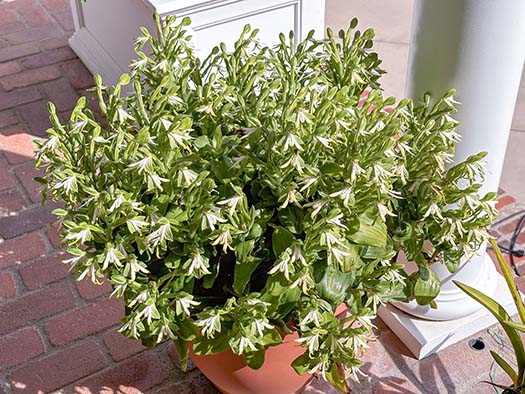 |
|
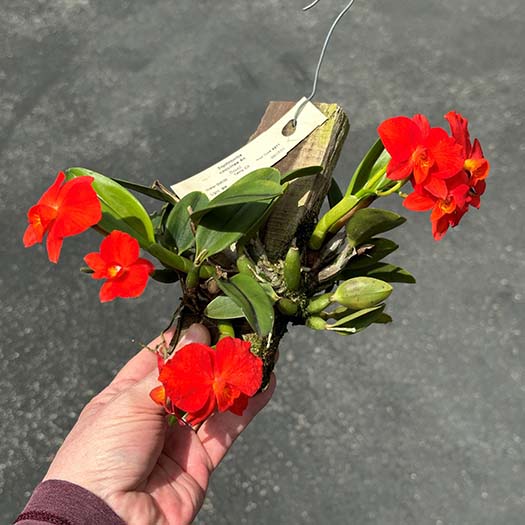 |
 |
Cattleya (Sophronitis) coccinea 4NOpening a few flowers at a time, these bright red flowers brighten the winter orchid collection. The flowers grow about 50% larger as they open over a couple days as you can see in the second pic with a larger flower and a smaller, newly opened flower. These pictures were taken on an iPhone, which like most consumer-grade cameras, oversaturates the reds to make faces look nicer but completely oversaturates on these flowers! |
|
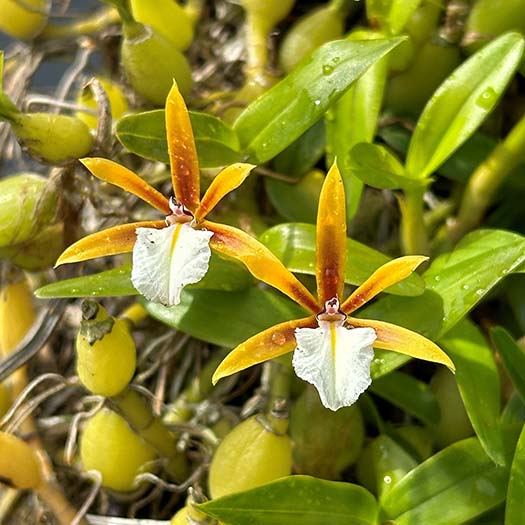
Dinema polybulbon 'Golden Gate'A fast-growing creeping plant. Seems less than typically floriferous this year for some reason. |
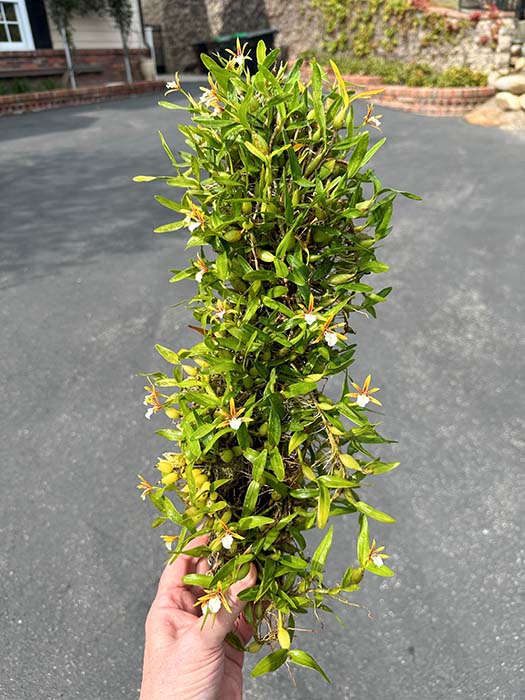 |
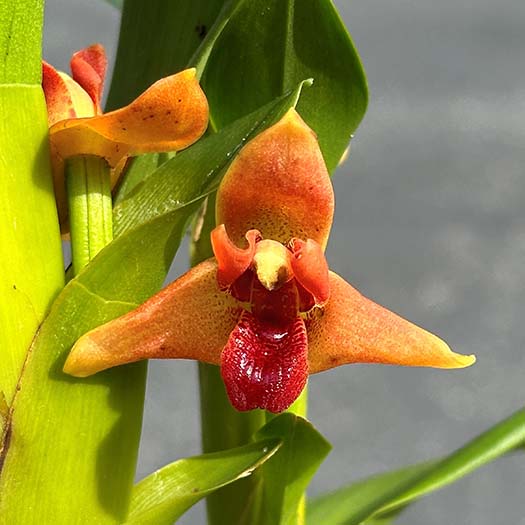
Maxillaria elatiorA very robust and vertical 3’ plant growing in a 2” pot. The flowers emerge from the base of the leaves. |
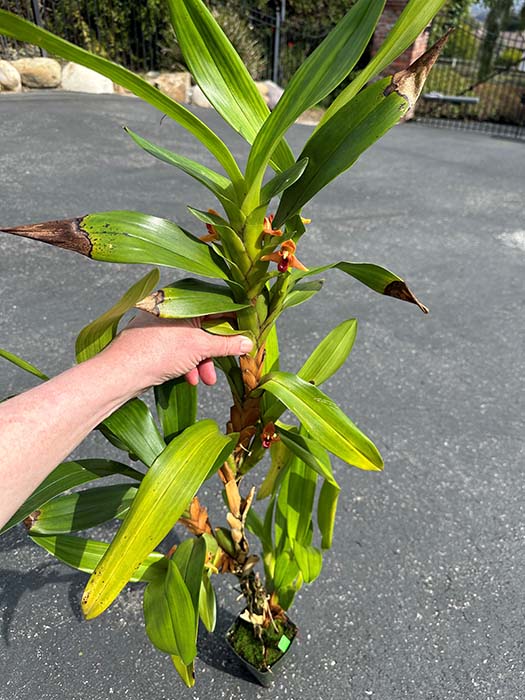 |

Pterostylis curtaMine seem to be moving very slowly this year, producing flowers over a longer time rather than a flush bloom.
|
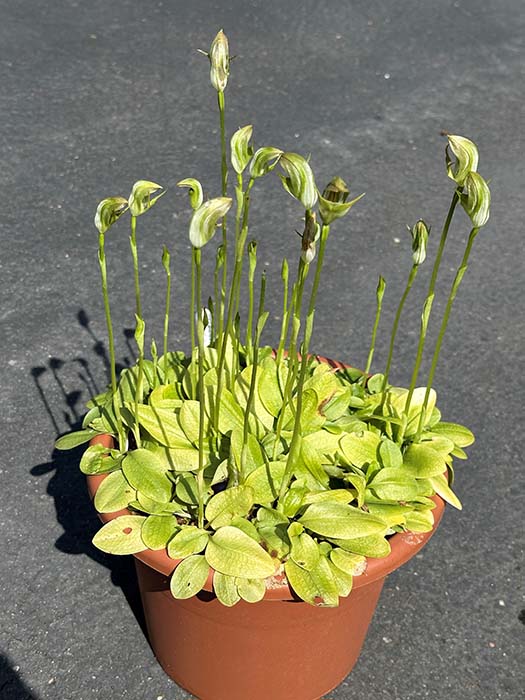 |
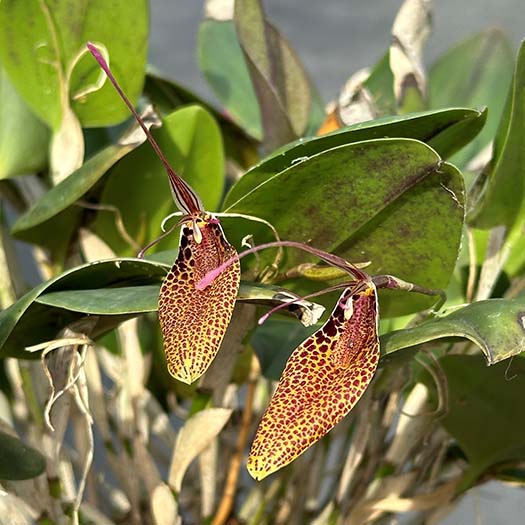
Restrepia antennifera 'Type A'Restrepias love this year’s rainy weather! This is a spotted variety of R. antennifera with relatively large flowers. |
|

Satyrium coriifoliumA (relatively) easy-growing Mediterraneum-climate terrestrial from the southwestern tip of South Africa. I have some NBS seedlings of S. rosea that are two years out of flask, and a primary hybrid between S. rosea and S. coriifolium that are growing well I hope will bloom next year. |
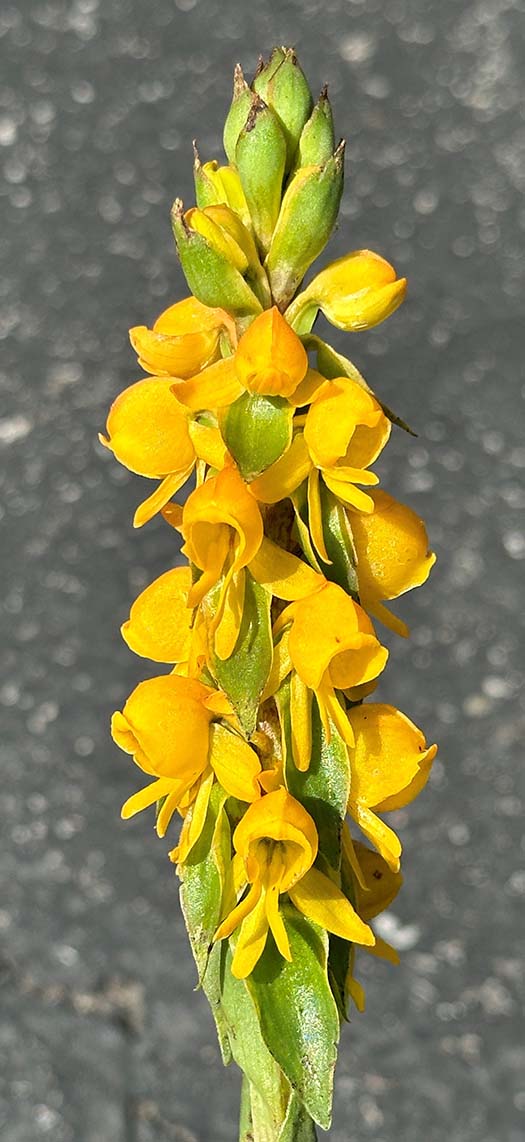 |
From Roberta Fox:Coastal southern California |
|
Outside in the Back Yard: |
|
 |
|
Brassia (Ada) aurantiacaThese flowers look especially brilliant on cloudy days. Flowers don't open fully, the inflorescences look like flames. This year, 10 spikes. |
|
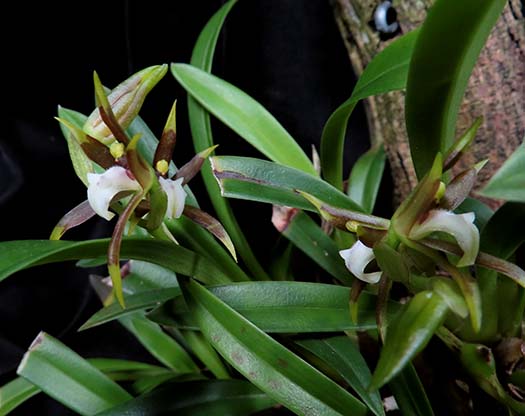
Brassia (Ada) brachypusWith opposite "personality", this little Brassia tends to hide among the leaves. It is a charming miniature. |
|
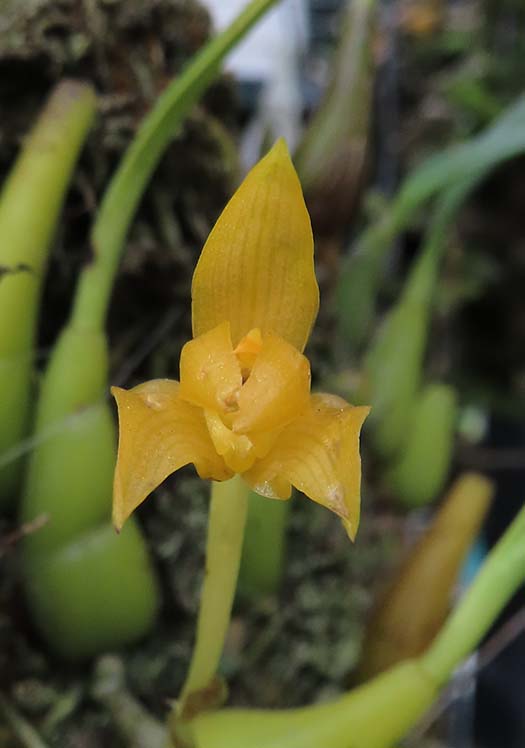
Bulbophyllum hamatipesNative to Java at a range of elevations up to 1800 m. It grows vigorously on a mount (so clearly can handle some drying), outdoors so it can handle cold. Would it bloom better if warmer? Maybe. But it seems to be thriving.
|
|
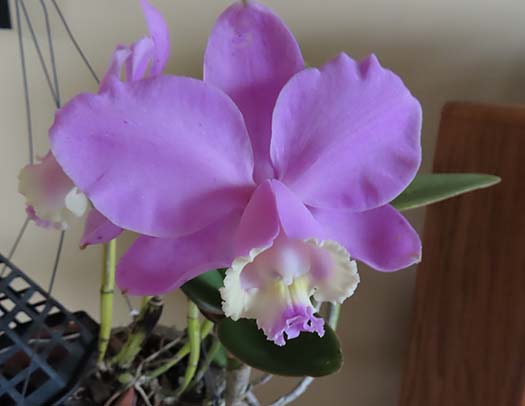
Cattleya loddigesiiThis plant tolerates whatvever nature throws its way. it has mostly escaped the wood basket, is growing more like a mounted plant. Flowers are particularly flat and shapely. |
 |
Dendrochilum parvulumThis miniature has a great flower-to-plant ratio. Leaves are about 2 inches, the plant grows on a 4 inch mount and almost forms a ball. It is a flower machine. Native to the Philippines at around 1200 m, cool temperature clearly don't bother it. |
|
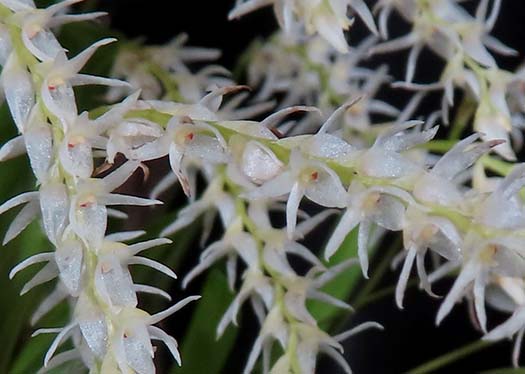 |
|
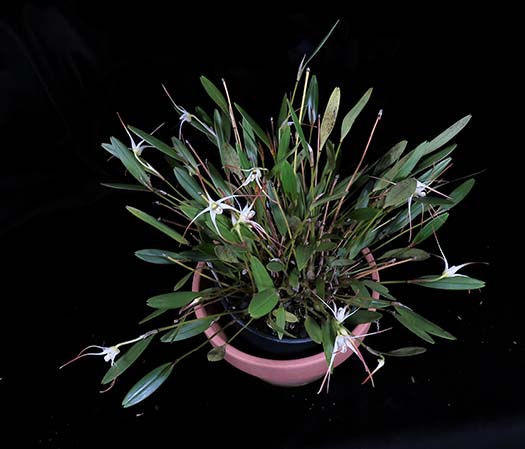
Diplocaulobium aratriferumI have shown this mysterious plant before, but each time it produces a flush bloom I get very excited. There is the anticipation as the buds emerge quite suddenly. The blooms last only 4-6 hours so don't blink, you may miss it! And often (but not always) my plant and Scott's two plants bloom at exactly the same time though they're located some 30 miles apart. Scott and I have tried to determine some pattern - temperature, air pressure, phase of the moon... each time we think we have figured it out, there is an exception that reminds us that correlation does not necessarily imply causation. The mystery continues. But the watermelon fragrance is wonderful and it never ceases to thrill. |
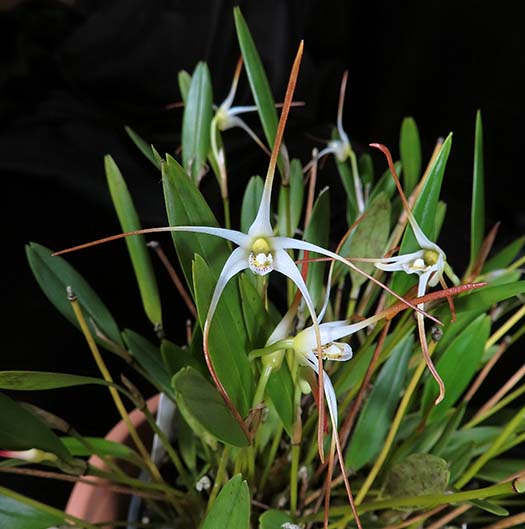 |

Diuris orientisThe spring-bloomng Mediterranean-climate terrestrials are growing vigoriously. This "donkey orchid" comes from eastern Australia, as its name implies. |
 |
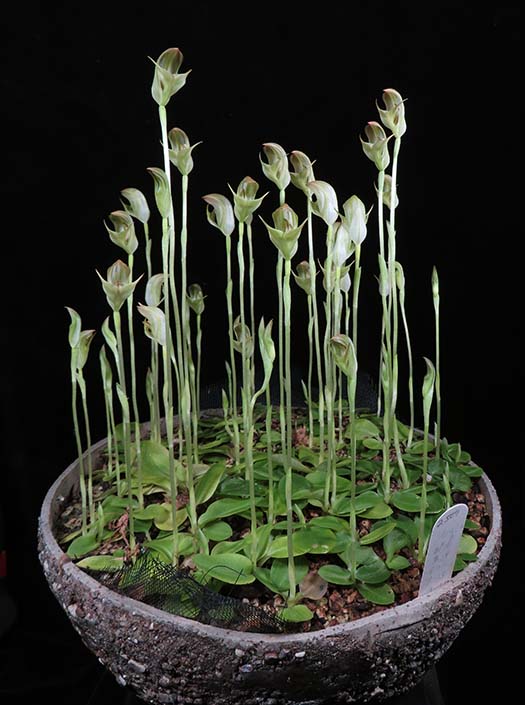 |
|
Pterostylis curtaThis Australian terrestrial has been in bloom for awhile. It comes from a ripaian habitat, and has a much shorter dormancy than the other Australian terrestrials that I grow. The tubers will get repotted in mid-July, and start receiving a bit of water by the end of July or early August while the other terrestrials won't get watered until October. |
|
 2.jpg)
Ophrys cretica (ariadne)This was the first of my European terrestrials to bloom. It is native to Crete (as the name implies) and Aegean islands. |
 1.jpg) |
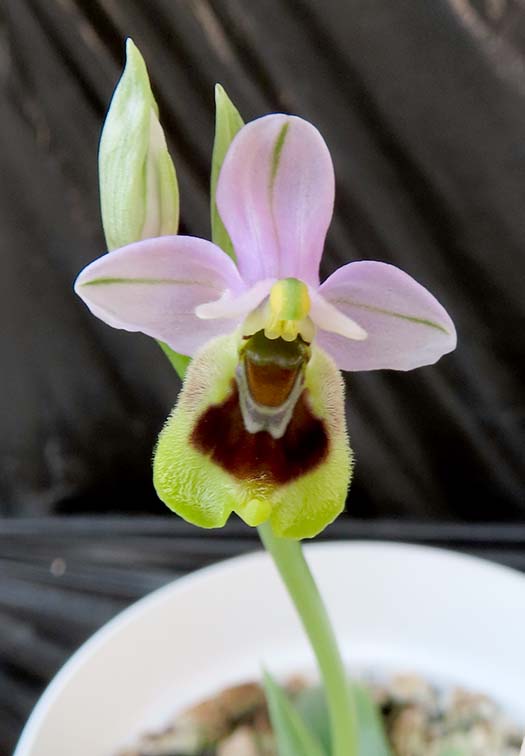 |
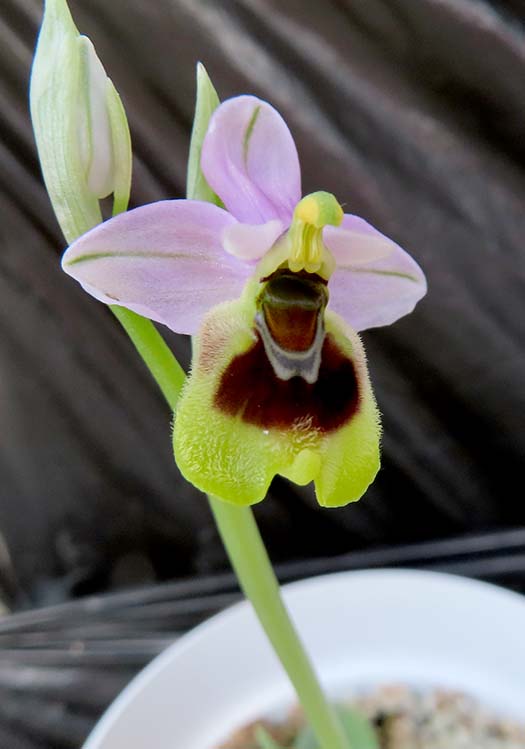 |
Ophrys tenthrediniferaThis is one of my favorites with its lovely contrasting colors. It is native to many of the countries surrounding the Mediterranean. (Compare with the one that Kurt shows to see some of the color variation of the species.) |
|
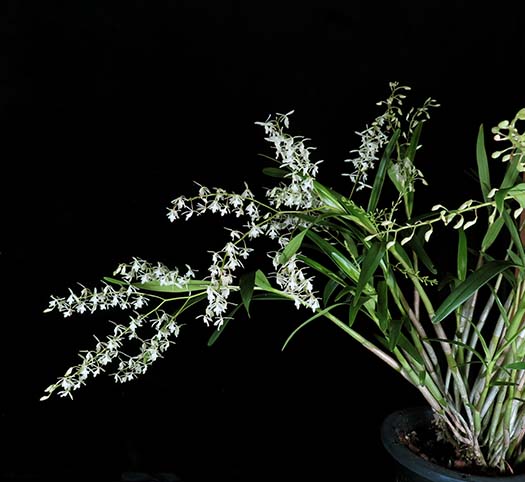
Epidendrum purumThis plant is very vigorous. It is native to Venezuela, Colombia, Ecuador, Peru, and Bolivia at a range of elevations from 500 to 2800 m. Basically, it can grow just about anywhere in southern California.
|
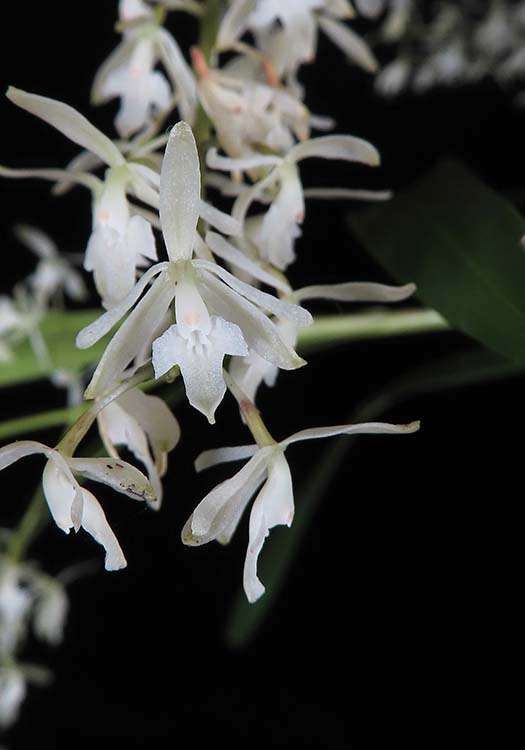 |
Lycaste virginalis (skinneri)This is the best blooming that I have had in many years. I think it really liked the wet, cool weather from both last year and now. Flowers are very long-lasting, nearly 2 months. |
|
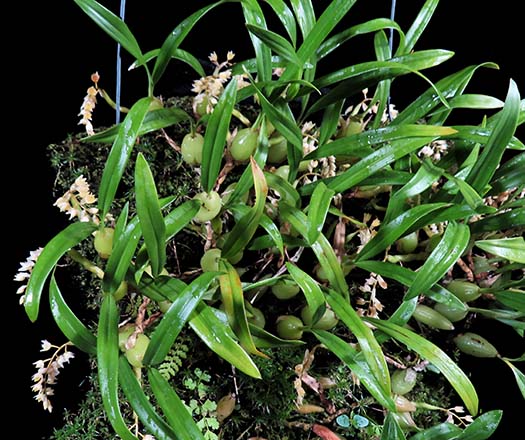
Pholidota cantonensisThe plant rambles over the surface of a hapu'u plaque, and each growth can produce these little inflorescences. Flowers are reminiscent of Dendrochilum. (OK, they're all Coelogynes now...) It is native to Tawan and several provinces of mainland China, over a wide range of elevations. |
|
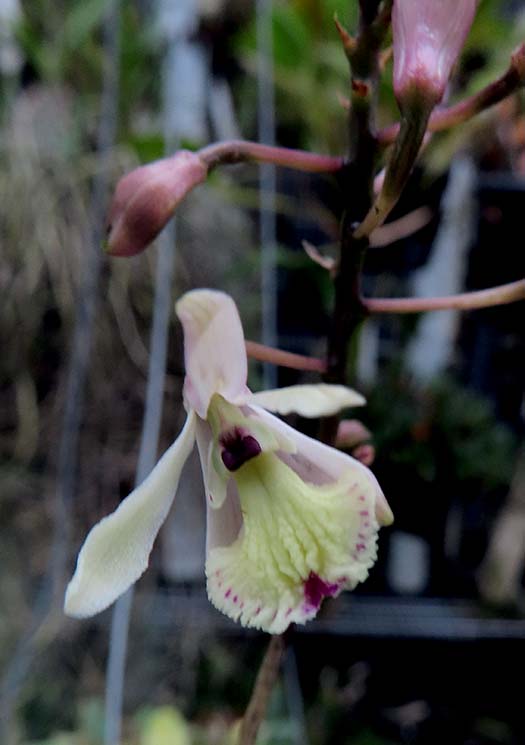 Pseudolaelia freyiIn Brazil, these grow up the sides of Vellozia bushes. The large hapu'u slab serves that purpose here. The pot was a place to start the division, may contain a few roots, but most of the plant is in the air. |
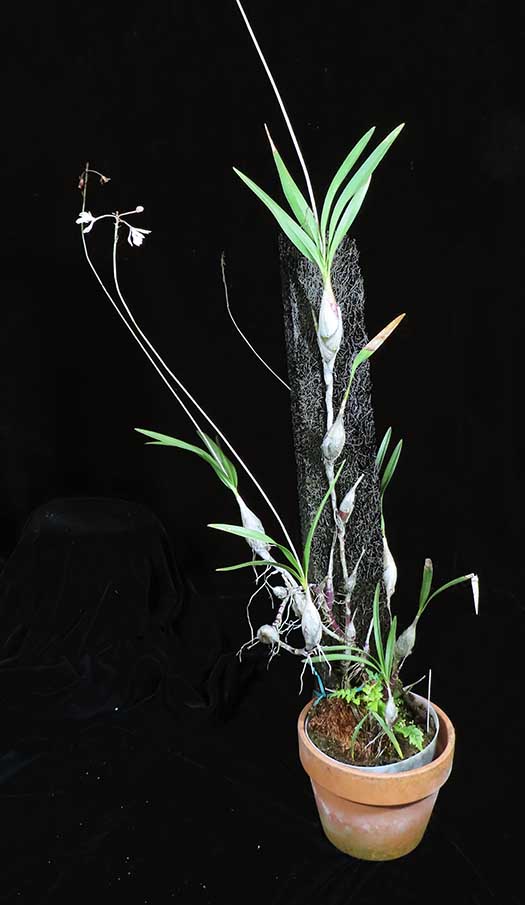 |
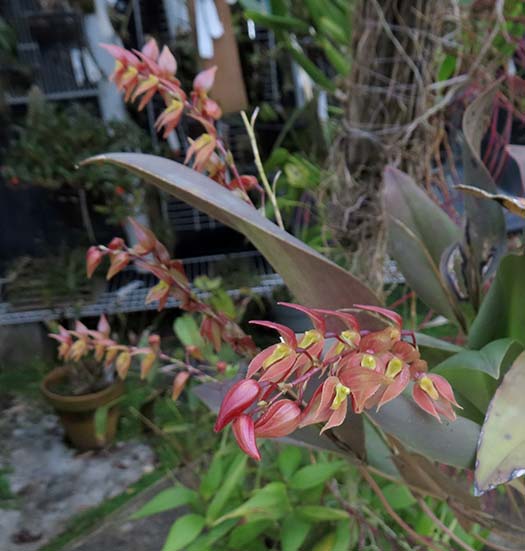
Pleurothallis alvaroiRelatively large and colorful flowers for the genus. They are also relatively long-lasting. |
|

Pleurothallis rowleeiLots of flowers in a flush bloom, but they are qute short-lived. |
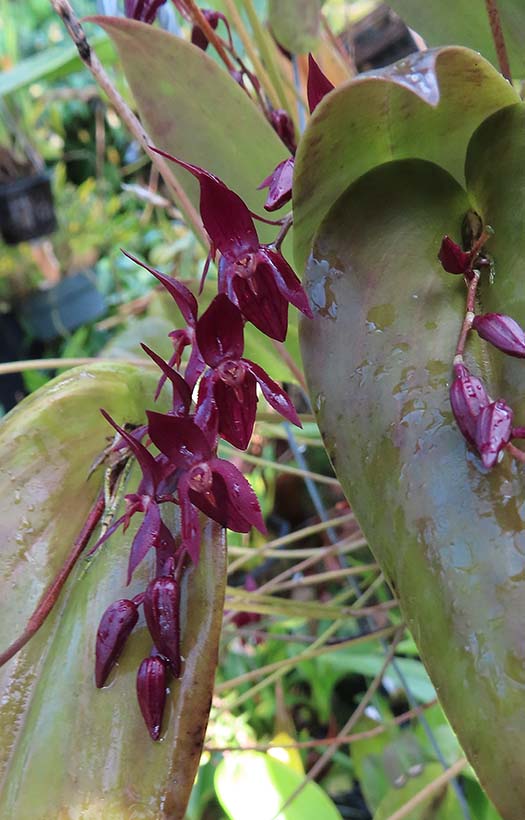 |
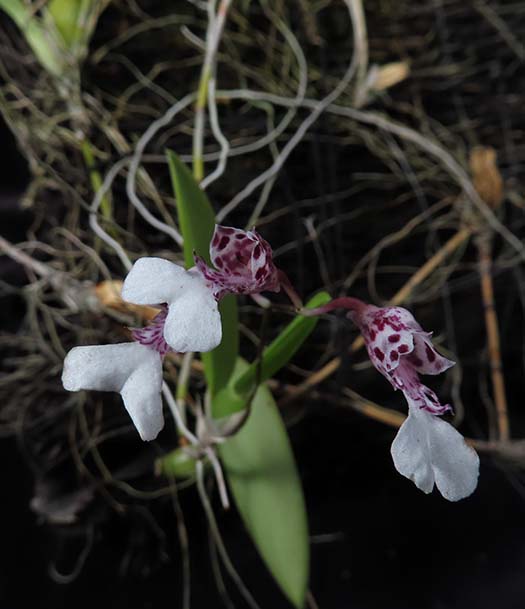
Rodriguezia decoraThis is a keiki machine, rambling over a hapu'u slab. Each growth can produce these intricate flowers. |
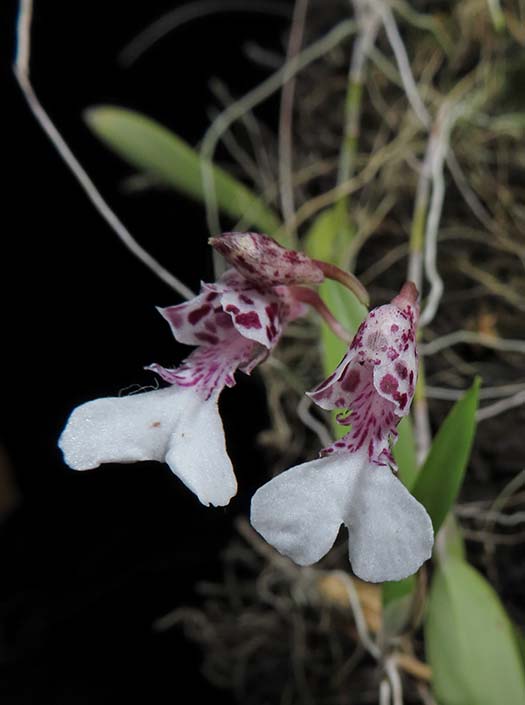 |
 |
|
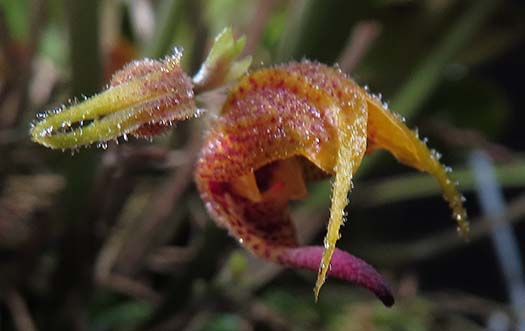 |
|

Trichocentrum canvendishianumThis is one of the relatively few Trichocentrum ("mule-ear Oncidium") species that comes from higher elevations and grows relatively cool. I have found it to be a rather shy bloomer, but seeems to be finally blooming at least every couple of years. (I grew it for 12 years to get first bloom!) It was well worth the wait. The plant doesn't take up a lot of room, and the flowers have heavy, almost waxy susbstance. It is native to central and southern Mexico, into El Salvador, Guatemala and Honduras, at elevations 1500-2800 m,
|
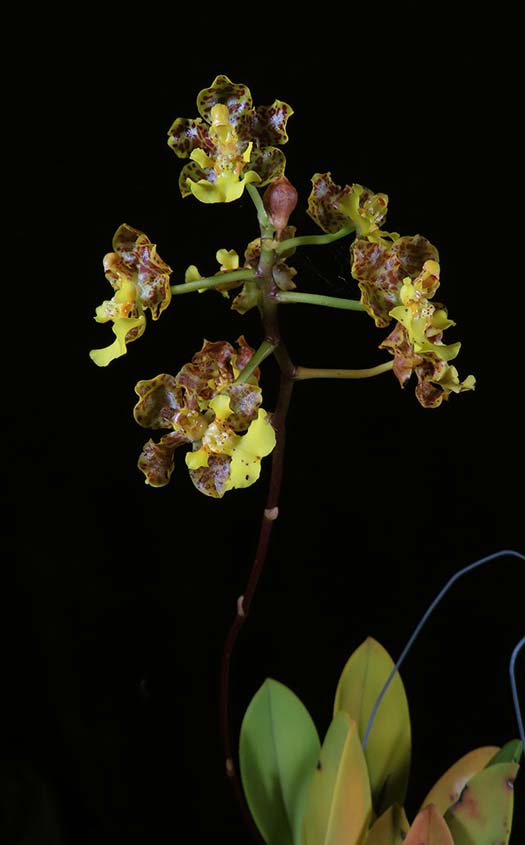 |
In the greenhouse... |
|
 Bulb. lasiochilumFrom South-Central China. Myanmar and Thailand, elevation range is reported to be 1200-1500 m, so it would probably do fine outside. It grows and blooms nicely in the greenhouse, but it may be a candiate for moving outside. |
|
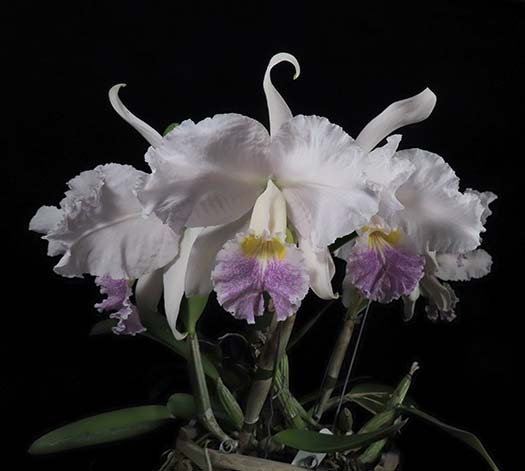
Cattleya lueddemannianaThis is one of the very few Cattleyas that I grow that needs a greenhouse. It isn't petite. But it is so pretty, it justifies the space required. Each flower is 6-7 incnes, and this blooming gave me 6 of them. |
 |

Chiloschista sweelimiiNative to Malaya, this leafless orchid needs both warmth and humidity. The roots house the chloroplasts that provide photosynthesis for the plant. |
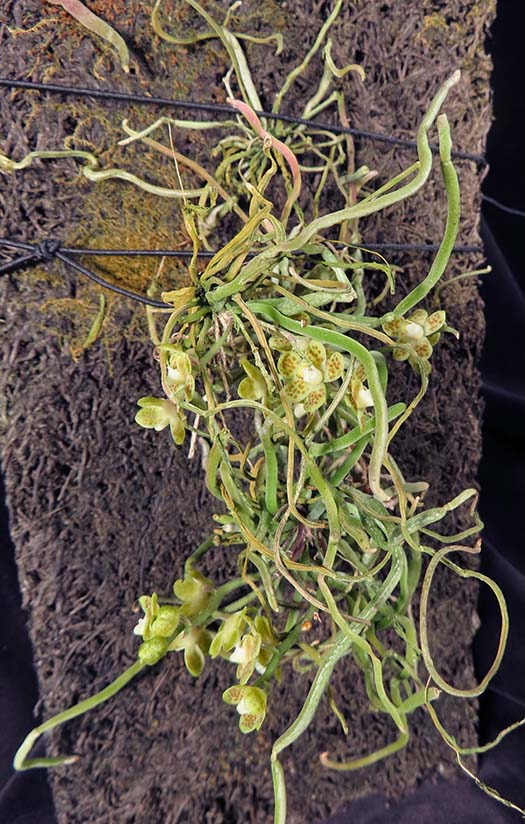 |
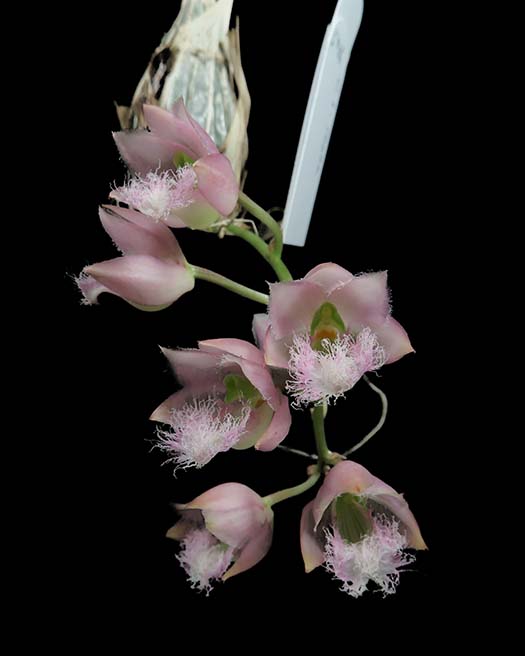 |
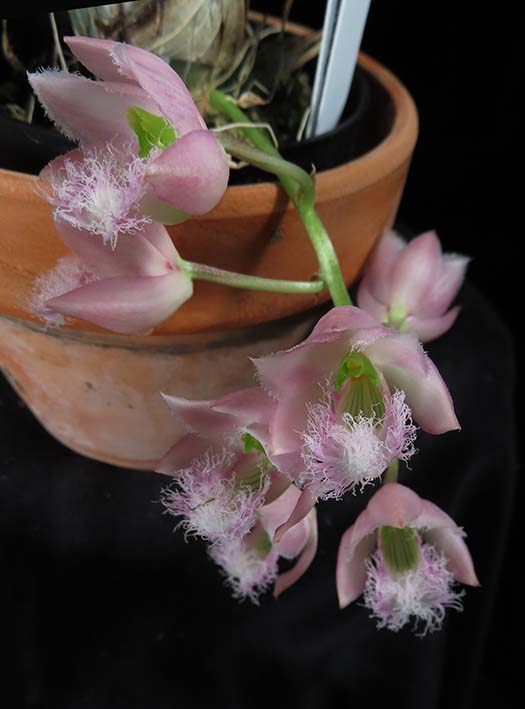 |
Clowesia roseaLike the rest of my Catasetinae, this one spends most of the year outside, but moves into the greenhouse once night temperatures drop below about 55 deg. F. This is a first-bloom seedling, just a baby. It blooms when it is completely dry and dormant. After the flowers fade, new growth will start, it will be another couple of months before it ready for water and for moving outside. It has a lovely spicy fragrance. It's the dominant parent of Cl. Rebecca Northen, and I had both in bloom at the same time so I could compare their fragrances - the hybrid has notes of citrus, a bit different. |
|
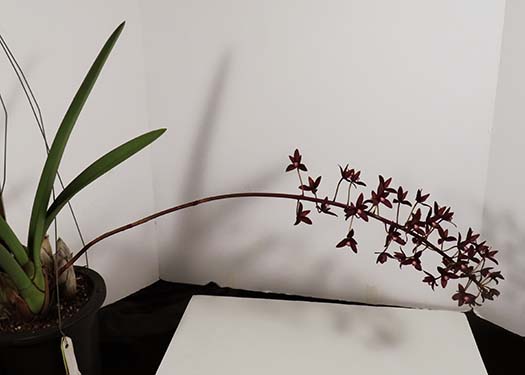 |
 |
Cymbidium canaliculatumThe culture for this species is different than for most Cymbidiums. It comes from northern Australia, from a warm and seasonally dry climate. It will spend the warmer months outside, but in winter it moves into the greenhouse with the Catasetinae. It isn't kept quite as dry as those, but watering is significantly reduced, no more than every 2 weeks or so. |
|
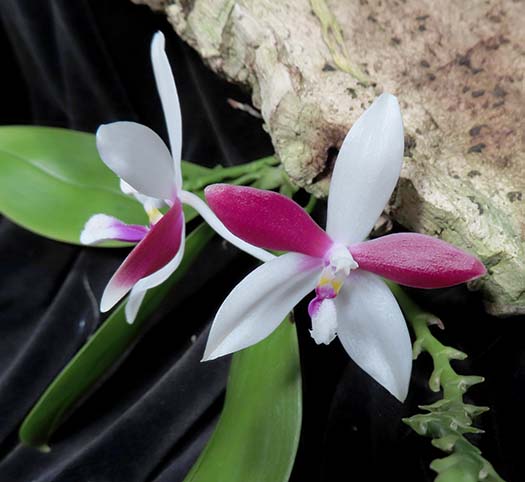 |
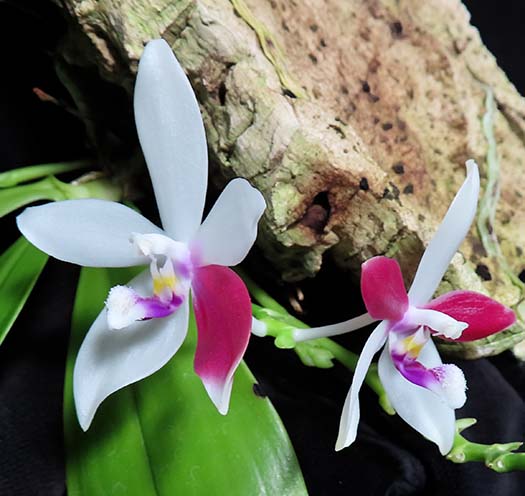 |
Phalaenopsis tetraspis (Syn. speciosa)Each flower is unique, any combination from pure white to pure red, in blotches or solid color, on any combination of segments. It blooms repeatedly from each inflorescence, so as the plant matures and adds new spikes, it can produce more flowers simultaneously, or at different times. |
|
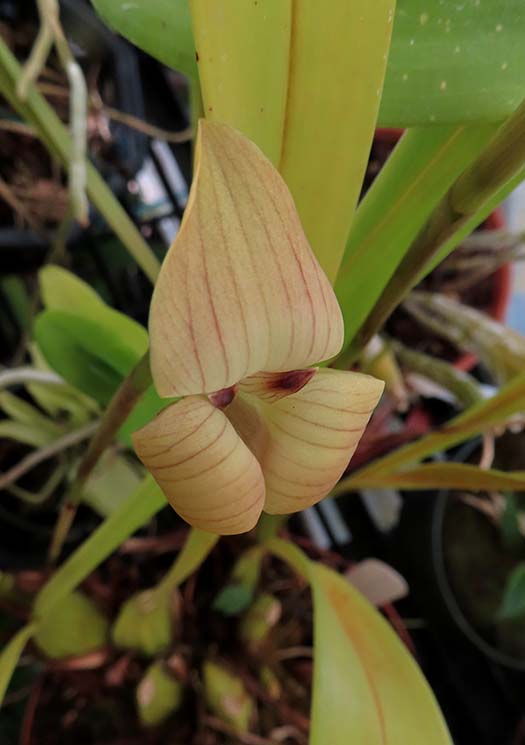 |
 wailesiana 2.jpg)
Warczewiczella (Cochleanthes) wailesianaI can't find much information about this one other than it is from Brazil. I don't know anything about its elevation range, but it is growing and blooming well in the greenhouse, so there it stays. It is very fragrant. |
Trigonidium egertonianumBlooms several times a year, and with each blooming produces flowers over a period of 6-8 weeks. Native to southern Mexico and much of Central America. It has been lumped into Maxillaria. |
|
